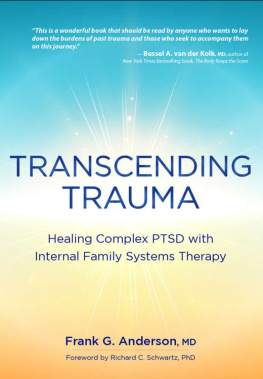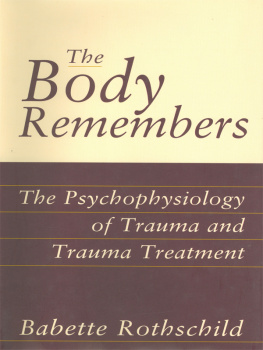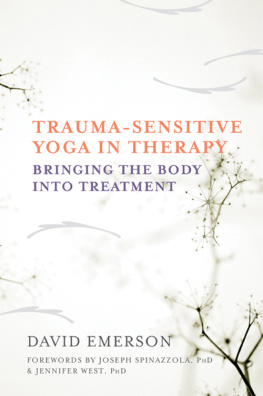
 | Attachment-Based
Yoga & Meditation |
for Trauma Recovery
Simple, Safe, and
Effective Practices for Therapy
Deirdre Fay
Foreword by Christopher Germer

W. W. Norton & Company
Independent Publishers Since 1923
New York London
A NORTON PROFESSIONAL BOOK
Note to Readers: Standards of clinical practice and protocol change over time, and no technique or recommendation is guaranteed to be safe or effective in all circumstances. This volume is intended as a general information resource for professionals practicing in the field of psychotherapy and mental health; it is not a substitute for appropriate training, peer review, and/or clinical supervision. Neither the publisher nor the author(s) can guarantee the complete accuracy, efficacy, or appropriateness of any particular recommendation in every respect.
Copyright 2017 by Deirdre Fay
Illustrations by Yuri Chen
All rights reserved
First Edition
For information about permission to reproduce selections from this book, write to
Permissions, W. W. Norton & Company, Inc., 500 Fifth Avenue, New York, NY 10110
For information about special discounts for bulk purchases, please contact W. W. Norton
Special Sales at specialsales@wwnorton.com or 800-233-4830
Production manager: Christine Critelli
The Library of Congress has cataloged the printed edition as follows:
Names: Fay, Deirdre, author.
Title: Attachment-based yoga & meditation for trauma recovery : simple, safe,
and effective practices for therapy / Deirdre Fay ; foreword by Christopher Germer.
Other titles: Attachment-based yoga and meditation for trauma recovery
Description: First edition. | New York : W.W. Norton & Company, [2017] |
A Norton professional book. | Includes bibliographical references and index.
Identifiers: LCCN 2016036770 | ISBN 9780393709902 (hardcover)
Subjects: | MESH: Mind-Body Therapies | Wounds and Injuriestherapy | Object Attachment
Classification: LCC RC489.M53 A88 2017 | NLM WB 880 | DDC 617.1/062dc23
LC record available at https://lccn.loc.gov/2016036770
ISBN 978-0-393-70991-9 (e-book)
W. W. Norton & Company, Inc., 500 Fifth Avenue, New York, N.Y. 10110
www.wwnorton.com
W. W. Norton & Company Ltd., 15 Carlisle Street, London W1D 3BS
To all of us who have ever been in pain:
May all who suffer, find peace.
May pain give rise to kindness and equanimity.
May our intimate contact with suffering bring forth a world of compassion and love.
May we remember our true nature,
welcoming in the spectrum of qualities that make us uniquely ourselves,
allowing ourselves to be guided from within, turning toward nourishment,
replenishing ourselves to live the life we want to live.
May we have the grace to know that mistakes arise to guide us, allowing us to course-correct, generating new avenues for relational repair.
H AFIZ, THE SUFI POET, writes, I know the way you can get when you have not had a drink of Love: Your face hardens, your sweet muscles cramp. (Ladinsky, 1996, p. 42). We know this intuitively. Without kindness, affiliation, warmth, and safety, faces tighten, close off. People feel empty and lost, even if presenting differently to the world. Those suffering from unresolved trauma or attachment issues hold this internal conflict in their eyes, in the muscles of their face and body, and in how their physical and psychological structures conform to protect against further harm.
Every child should have had the gift of safety from birth onwards. In that state of grace, a child flourishes, steps out beyond their comfort zone, makes mistakes, reaches for reassurance, learns and grows from mistakes without shame. Returning to a safe haven after stretching out into the world, the child finds out from others that theyll be okay despite anything untoward that happened. In this cocoon of care, a child naturally develops psychological safety (Bowlby, 1988; Holmes, 2001) with a native impulse to explore themselves and the world. A child raised in this environment would have an implicit ground in the myriad rhythms and patterns (Beebe et al., 2010, 2003; Beebe & Lachmann, 2014, 2002) of protest and response, engagement, and separation. But what about people who do not enjoy this gift of safety? As therapists, we take on the task of providing a nurturing framework for our clients to relearn how to be connected, safely, in collaborative relationships that are mutual and respectful.
Say that to a trauma survivor or a client with substantive attachment issues, and their eyes will lose focus as they sit in stunned silence. Or maybe theyll roll their eyes, responding with a reactive, What, are you crazy? Or as one of my clients would say, Time to take off those rose-colored glasses. That wasnt how it was, and I strongly doubt it is how it will be. Those flippant remarks of our clients hide, not always successfully, the longing for an embodied reality connected to themselves and to others.
I watched Melissa look at the clock, know that it was time to leave, and still pause. Slowly she made her way to the door, pausing yet again. I dont want to go, she said ever so softly. This is where I feel safe. Out there Ill be on my own.
Our clients leave our offices and are alone again. By themselves. Our offices, our relationships with them, provide the bridge connecting them to themselves. Then the moment comes when the session is over. This moment of being connected, to then being alone once again, can be heart-rending. Youve seen this, I know. That moment when both you and the client know its time to go. You watch the client wrap themselves up, put the pieces together in the only way they know how, so they can walk out the door without falling apart. Our task in therapy, and the practice for the client in almost every moment of life, is to recognize that underneath all the bravado no one has gotten off without suffering. Supporting our clients to connect to our common humanity (Neff, 2011) provides a way to ease the aloneness (Fosha, 2011, 2000).
Attachment theory helps us understand how difficult it is for even well-adjusted, healthy people to release the defenses that have kept them safe, and trust another person. Lacking the strong emotional bond of a secure attachment happens in as much as 40 percent of the population (Bakermans-Kranenburg & van IJzendoorn, 2009; Brown, Elliott, et al., 2016 Moullin, Waldfogel, & Washbrook, 2014). For our clients who have been chronically neglected, abandoned, betrayed, or traumatized, trust is hard to come by, yet it is the main threshold our clients must cross in order to heal their hearts, let alone their bodies and minds. Its in courageously stepping toward safety and trust that our clients co-create with us a new secure base from which they reorganize their attachment representations. In this explicitly integrative holding environment, our clients risk showing us their anger, contempt, judgment, disapproval, rejection, joy, vitality, and wisdom. As we welcome all aspects of their expression with appropriate boundaries, our clients develop internal safety, a trust in themselves that forms a self-structure allowing them to venture forth into the world from a new, more secure base.
Next page














